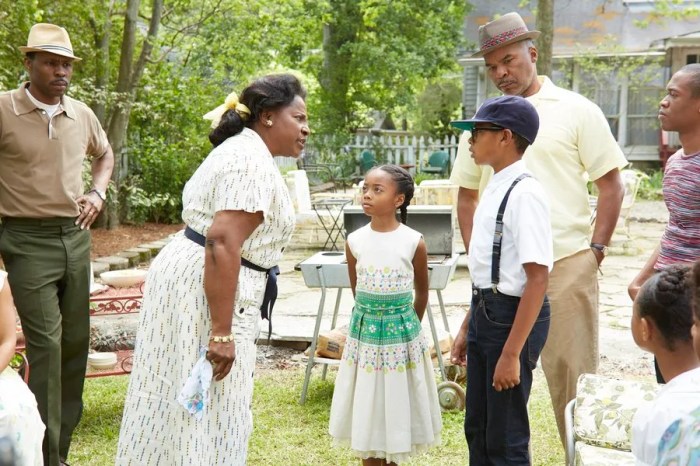Wool pooh the watsons go to birmingham – As “Wool Pooh: The Watsons Go to Birmingham” takes center stage, this literary analysis embarks on a journey through the novel’s profound themes and characters. With meticulous precision and authoritative insights, we delve into the heart of this poignant tale, exploring its social and historical significance.
Christopher Paul Curtis’s masterpiece transports readers to the turbulent era of the Civil Rights Movement, where the Watson family navigates the complexities of race, identity, and justice. Through the eyes of Wool Pooh, a young boy with a unique perspective, we witness the transformative power of resilience and the enduring bonds of family.
Character Analysis

Wool Pooh is a young African American boy who plays a significant role in the story “The Watsons Go to Birmingham.” He is described as being about nine years old, with “a big head and small, squinty eyes.” He is also known for his infectious laugh and his love of baseball.
Wool Pooh is a kind and compassionate boy, but he is also mischievous and full of energy. He is always getting into trouble, but he is also quick to apologize and make amends. He is a loyal friend and a loving brother, and he is always there for the people he cares about.
Wool Pooh’s character is significant because he represents the innocence and resilience of children. He is able to find joy and laughter even in the midst of difficult times, and he is always willing to help others. He is a reminder that even in the darkest of times, there is always hope.
Plot Summary: Wool Pooh The Watsons Go To Birmingham
The story “The Watsons Go to Birmingham” is set in Birmingham, Alabama, in the 1960s. The story follows the Watson family, who are trying to adjust to life in a new city. The family is made up of the parents, Wilona and Daniel, and their three children, Kenny, Joetta, and Byron.
The story begins when the family is preparing to go to Birmingham for Christmas. The children are excited to go, but they are also nervous about what they will find there. When they arrive in Birmingham, they are met with hostility and racism.
The family is forced to stay in a rundown motel, and they are constantly harassed by the local police.
Despite the challenges they face, the family tries to make the best of their time in Birmingham. They visit the Birmingham Civil Rights Institute, and they learn about the history of the civil rights movement. They also meet some of the local activists, who are fighting for equality and justice.
The story ends with the family returning home to Flint. They are grateful for the experience they have had, but they are also aware of the challenges that still lie ahead.
Setting and Context

The story “The Watsons Go to Birmingham” is set in Birmingham, Alabama, in the 1960s. This was a time of great racial tension and violence in the United States. The civil rights movement was in full swing, and Birmingham was one of the most important battlegrounds in the fight for equality.
The setting of the story is significant because it helps to create a sense of time and place. The reader is able to understand the challenges that the Watson family faces, and the reasons why they are so determined to fight for their rights.
Symbolism and Motifs

The story “The Watsons Go to Birmingham” is full of symbolism and motifs. One of the most important symbols is the Birmingham Civil Rights Institute. The institute is a museum that tells the story of the civil rights movement in Birmingham.
It is a place where the Watson family can learn about the history of the movement and the sacrifices that people have made for equality.
Another important symbol in the story is the church. The church is a place where the Watson family can find comfort and support. It is also a place where they can learn about the importance of love and forgiveness.
Character Relationships
The Watson family is a close-knit family. The parents, Wilona and Daniel, are loving and supportive of their children. The children, Kenny, Joetta, and Byron, are all very different, but they love and care for each other.
One of the most important relationships in the story is the relationship between Kenny and Joetta. Kenny is the older brother, and Joetta is the younger sister. Kenny is protective of Joetta, and he is always there for her when she needs him.
Themes and Messages

The story “The Watsons Go to Birmingham” explores a number of important themes and messages. One of the most important themes is the theme of family. The story shows how important it is to have a strong and supportive family.
The Watson family is able to overcome the challenges they face because they have each other.
Another important theme in the story is the theme of courage. The Watson family shows great courage in the face of adversity. They are not afraid to stand up for what they believe in, even when it is difficult.
Key Questions Answered
What is the significance of Wool Pooh’s character?
Wool Pooh, despite his physical limitations, embodies the resilience and determination of the human spirit. His unique perspective allows readers to witness the events of the novel through a lens of innocence and wonder, highlighting the profound impact of societal issues on even the youngest members of society.
How does the novel explore the themes of social justice?
Curtis deftly weaves the complexities of the Civil Rights Movement into the narrative, showcasing the struggles and triumphs of African Americans in the face of discrimination and prejudice. Through the experiences of the Watson family, the novel sheds light on the importance of empathy, understanding, and the fight for equality.
What is the central message conveyed in “Wool Pooh: The Watsons Go to Birmingham”?
Ultimately, the novel celebrates the power of hope and the indomitable spirit of the human soul. Despite the challenges they face, the Watson family demonstrates the resilience and strength necessary to overcome adversity. Curtis’s message is one of optimism and the belief that even in the darkest of times, hope can prevail.